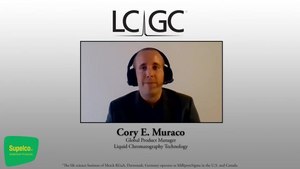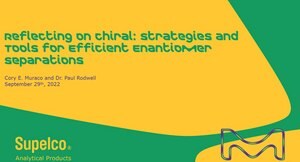HPLC Columns

Supelco® HPLC and UHPLC columns meet today’s demands of fast U/HPLC, LC-MS, and biopolymer separation, as well as regulated pharmacopeia and agency methods within various industries. Supelco® HPLC products are available with Fused-Core® particle technology, monolithic silica, and fully porous particles, including ultra-pure silica. In addition, porous graphitic carbon (PGC) particles, and polymeric particles are available for high pH stability.
View featured products:
- Porous Graphitic Carbon (PGC) Particles
- Superficially Porous Silica Particles (SPP)/Fused Core® Technology
- Monolithic Silica
- Fully Porous Silica Particles (FPP) Type B (High Purity Silica)
- Fully Porous Silica Particles (FPP) Type A (Conventional Silica)
- Fully Porous Polymeric Particles
- Chiral HPLC Columns
Related Product Resources
Porous graphitic carbon (PGC) particles
Porous graphitic carbon (PGC) columns, like the Supel™ Carbon LC column, provide unique chromatographic properties that are unmatched by silica particle-packed columns. The full pH range can be used as well as high temperature (> 200 °C), opening up new frontiers for chromatographers.
Superficially porous silica particles (SPP)/Fused Core® Technology
Superficially porous silica columns deliver higher speed and efficiency than fully porous particles of the same size. Fused-Core® HPLC columns like Ascentis® Express and BIOshell™ can convert any HPLC system into a fast HPLC workhorse with maximum speed and performance.
Monolithic silica
- Monolithic, silica-based HPLC columns such as Chromolith® HPLC columns allow rapid separations at very low column backpressure with high matrix tolerance and extended column lifetime, thus making them ideal products for high throughput and cost-efficient analyses of matrix rich samples.
- Chromolith® HPLC columns are made from monolithic silica with a bimodal pore structure having 2 µm macropores and 13 nm mesopores. This structure leads to various key advantages to the column.
- Chromolith® WP columns are wide pore (300 Å) monolithic silica columns made up of a single continuous rod of high purity, porous silica. These columns have shown great potential compared to conventional columns with consistent performance over a longer lifetime. In addition to various RP phases, a Protein A affinity column and an epoxy column, that enable customer specific modifications, are also available.
Fully porous silica particles (FPP) Type B (high purity silica)
- Purospher® STAR HPLC and UHPLC columns are best suited for the peak-tailing free separation of basic, neutral, and metal chelating samples. Their superior performance and stability allow maximum flexibility in method development with extended pH stability.
- Discovery® HPLC columns are efficient for the analysis of biomolecules and small molecules. These columns have polar and non-polar bondings, with unique retention, selectivity, and no-bleed properties for LC-MS applications.
- The Ascentis® bonded phases have a wide range of selectivity. Type B silica makes the column inert, stable, and reproducible. The high surface area of the silica is suitable for preparative loading capacity.
- SeQuant® HILIC HPLC columns (hydrophilic interaction liquid chromatography) carry densely bonded, zwitterionic functional groups. These HILIC columns are available in a variety of lengths, particle sizes, and pore dimensions while showing an exceptional reproducibility and robustness.
- Sepax® HPLC columns are highly porous silica-based columns mainly utilized for peptides and protein analysis.
Fully porous silica particles (FPP) Type A (conventional silica)
- Supelcosil® silica-based HPLC column line has a wide range of bonded phase chemistries, with the particle sizes and column configurations ranging from microbore to preparative scale. These columns show great efficiency for polar, nonpolar, and charged analytes.
- LiChrospher® and Superspher® HPLC columns are highly versatile and reliable, proven in thousands of established HPLC methods.
- LiChrosorb® HPLC columns are packed with irregular silica particles ranging from analytical scale 5 µm to large particles sized for production scale.
- TSKgel® HPLC and UHPLC columns are available for gel filtration, gel permeation, ion exchange, reversed-phase, hydrophobic interaction, hydrophilic interaction, and affinity chromatography. (only available in the US and Europe)
Fully porous polymeric particles
- apHera™ reversed-phase and amino HPLC columns are stable at the pH range 2-12 and are amenable to washing with alkaline solutions. They are ideal for the analysis of peptides, small proteins, carbohydrates, polar drugs, and organic acids.
- Supelcogel® HPLC columns are packed with polystyrene-divinylbenzene co-polymer (PS-DVB) making them chemically stable. The two variations of PS-DVB co-polymer (6% and 8% cross-linked) maximize the separation process of the samples.
- Hamilton Polymeric Reversed Phase HPLC columns are extremely inert, efficient, and durable, with high mechanical and thermal stability.
- TSKgel® HPLC and UHPLC columns are available for the separation of proteins, peptides, and other biomolecules. The columns containing silica and methacrylate particles with different pore sizes can accommodate analytes with a wide range of molecular weights. (only available in the US and Europe)
Chiral HPLC Columns
We have a wide range of chiral HPLC columns for various applications.
- Astec CYCLOBOND™ Chiral columns have bonded cyclodextrin phases that allow selective chemical separation of organic molecules.
- Astec CHIROBIOTICTM Chiral columns are based on macrocyclic glycoproteins bonded to high purity silica gels available for LC-MS chiral applications.
- Astec Cellulose DMP Chiral columns with spherical, high-purity porous silica coated with DMPC (3,5-dimethylphenyl carbamate); can separate a wide range of chiral compounds under normal phase, polar organic, and SFC conditions.
- Astec Copper Ligand Exchange Chiral columns are beneficial for resolving hydroxy acids, amino acids, bi-functional racemates, and other amines.
Related Webinars
In this webcast, the origins and problems in LC–MS arising from impurities and contaminations will be described in detail and tips and tricks will be provided in order to enable or maintain high quality and high sensitivity LC-MS analyses.
Learn about porous graphitic carbon, a stationary phase material that is fully porous, carbon-based material—it is capable of analyzing small molecules and smaller proteins and peptides.
Quantitation of monoclonal antibodies by LC-MS is a difficult analytical challenge due to the complexity in the workflow, from sample prep to LC-MS quantitation. This presentation will highlight a simple and high throughput method for the quantitation of monoclonal antibodies and proteins in human and animal serum.
The focus of this seminar is to provide an overview of different strategies and methods employed over the past several years in characterizing samples containing chiral compounds.
This presentation focuses on recent advances, in the past two years, in 'carbon-HPLC' in the analysis of compounds classically associated with being difficult to separate by conventional 'silica-HPLC.'
Join our webinar focusing on "How to Increase The Cost Effectiveness for HPLC Separations of Challenging and Matrix-rich Samples" for the potential for cost and time savings by increasing lab productivity with faster separations and column materials providing very high matrix tolerance.
*Tosoh Bioscience columns are available in the following countries:
| Albania Andorra Argentina Armenia Austria Azerbaijan Afghanistan Algeria Albania Armenia Azerbaijan Belarus Belgium Belize Bolivia Bosnia & Herzegovina Brazil Bulgaria Bahrain Belarus Bosnia-Herz Botswana Burkina-Faso Canada |
Chile Colombia Costa Rica Croatia Cuba Dominican Republic Cyprus Czechia Cameron Central Afr. Rep Chad Congo Congo dem. Rep. Croatia Denmark Djibouti Ecuador Egypt El Salvador Eritrea Ethiopia Estonia Finland France French Guiana |
Georgia Germany Greece Gabon Georgia Ghana Guatemala Guyana Haiti Honduras Hungary Iceland Ireland Italy Iraq Israel Kazakhstan Kosovo Kazakhstan Kenya Kosovo Kuwait Kyrgyzstan Lebanon |
Libya Latvia Liechtenstein Lithuania Luxembourg Madagascar Malawi Malta Mauretania Mauritius Mexico Moldova Monaco Montenegro Moldavia Mongolia Morocco Mozambique Nicaragua Nigeria Netherlands North Macedonia (formerly Macedonia) Norway |
Oman Panama Paraguay Peru Poland Portugal Puerto Rico Qatar Russia Rwanda Romania Russia San Marino Serbia Slovakia Slovenia Spain Sweden Switzerland Saudi Arabia Senegal Serbia Serbia-Montenegro South Africa |
Suriname Tadzhikistan Tanzania Togo Tunisia Turkey Ukraine Uruguay Turkmenistan United Kingdom (UK) United States of America Uganda Ukraine Utd.Arab.Emir. Uzbekistan Vatican City Venezuela Yemen Zambia Zimbabwe |
To continue reading please sign in or create an account.
Don't Have An Account?




